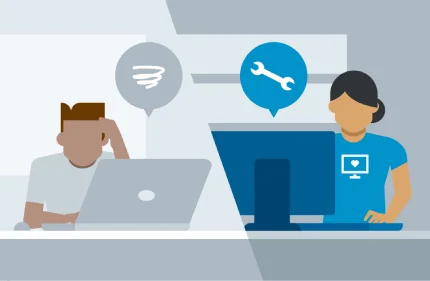What is a Service Desk?
Aservice deskis a centralized hub that handles IT support, manages service requests, and resolves incidents. It's where end-users go to get help, report issues, request services, and interact with the IT department.
But a modern service desk does more than just react to problems.
It provides:
- 🔁 Incident Management
- 📦 Service Request Fulfillment
- 🔍 Problem & Root Cause Analysis
- 📈 Change Management Support
- 🧠 Knowledge Base Integration
- 🤝 End-User Experience Optimization
Whether you're managing hundreds of endpoints or servicing thousands of users across departments and geographies, theIT service deskacts as yourfrontline of IT excellence.
Key Features of a Service Desk
- 🛠️ Unified Ticketing System
Track, manage, and prioritize incidents, service requests, and problems from a single pane of glass—assign technicians, escalate issues, and close tickets with confidence. - 📡 Multi-Channel Support
Let end-users submit requests via email, web portal, chat, or phone—ITarian’s omnichannel intake keeps every conversation and request organized. - 🔄 Workflow Automation
Automatically route tickets, send status updates, and trigger SLA escalations. Eliminate manual busywork and free your team to focus on high-impact support. - 📚 Knowledge Base Integration
Deflect tickets and empower users with self-service articles, FAQs, and troubleshooting guides—all natively accessible from the service desk. - 🎯 SLA Management
Define and track custom service-level agreements. Get real-time alerts when a ticket is about to breach and maintain accountability across your team. - 📈 Reporting & Analytics
Visual dashboards help you monitor ticket volumes, resolution times, technician productivity, and overall customer satisfaction.
Why the Service Desk is Mission-Critical
Support isn’t a secondary function—it’s a brand-defining moment.
Every ticket you resolve (or drop) shapes how users trust your business. And in today’s hybrid work environment,response time is reputation.
That’s why leading businesses are investing in smarter, more automated IT help desk services:
- 📉Reduce Downtime:Rapid response to issues = more productive employees
- 🔄Boost Retention:Frictionless IT builds employee satisfaction and trust
- 📊Drive Efficiency:Triage, escalate, and resolve at speed with automation
- 💡Empower Users:Knowledge bases enable self-help for repeat issues
- 🔒Improve Security:Centralized ticketing ensures incidents are tracked and audited
Service Desk vs Help Desk: What’s The Difference?
Many people confuse the terms service desk and help desk. While they share similarities, here’s how they differ:
| Feature | Help Desk | Service Desk |
|---|---|---|
| Scope | Incident resolution only | Full lifecycle of IT services |
| Focus | Break-fix problems | Proactive IT service delivery |
| Strategic Alignment | Operational support | Aligned with ITIL and business objectives |
| Processes | Basic ticketing | Incident, problem, change, and request management |
| Value | Short-term support | Long-term IT value and improvement |
In short:A help desk solves immediate issues. Aservice desk transforms IT delivery.
How IT Service Desks Evolve IT Strategy
At ITarian, we believe your service desk is more than a ticket system—it’s an engine for transformation.
Here’s how our platform powers your evolution:
- From Manual to Automated
Replace repetitive triage and routing with rules, triggers, and macros. - From Reactive to Proactive
Solve problems before they recur. Use analytics to drive permanent fixes. - From Fragmented to Unified
Bring all user interactions, devices, and support activities into one platform. - From Support to Strategy
With reporting and insights, IT becomes a business enabler—not just a cost center.
Who Should Use a Service Desk?
The short answer? Anyone serious about IT support.
- ✅ Managed Service Providers (MSPs)
Manage tickets across multiple client environments with role-based access, multi-tenant dashboards, and full RMM/patch/security integration. - ✅ In-House IT Departments
Deliver enterprise-grade support to employees from a single platform—whether you're managing 50 users or 5,000. - ✅ Educational Institutions
Track hardware issues, reset passwords, and empower students/faculty with fast, reliable IT help desk services. - ✅ Healthcare, Government, and Retail
Ensure uptime, meet compliance needs, and deliver user-first experiences in regulated and high-volume environments.
What Makes ITarian the Smart Choice for IT Help Desk Services?
In a crowded market of legacy helpdesk tools and bloated ticketing systems, ITarian does things differently:
- 🧩Modular:Add service desk capabilities into your IT stack with a single click.
- ⚙️Integrated:Seamlessly connects with ITarian’s RMM, endpoint management, patching, and security tools.
- 🌐Cloud-Native:No servers, no maintenance—just a fast, secure platform you can access anywhere.
- 💰Free Forever Option:Get started with zero cost. Upgrade only when your needs grow.
Most importantly, we designed our IT service desk for real IT teams—not for corporate compliance reports, not for flashy UI awards, but for the ones on the front lines, solving real problems.

